Analyzing Terrorism: Criminology Theories, Impact & Influences in AU
VerifiedAdded on 2023/06/04
|5
|1405
|67
Essay
AI Summary
This essay examines the phenomenon of terrorism, focusing on its influences and societal impact, particularly within the Australian context. It defines terrorism as an act of violence against societal norms, causing harm to innocent citizens, and explores the factors contributing to such acts through the lens of criminology theories, specifically the general strain theory and the conflict theory. The essay discusses the far-reaching impacts of terrorism, including mental, physical, financial, and sociological consequences, emphasizing how it undermines the sense of safety and incurs significant financial burdens due to counter-terrorism efforts. It explains how the general strain theory posits that terrorism arises from collective strains experienced by citizens, leading them to criminal activities, while the conflict theory suggests that terrorism stems from conflicts of interest and a perception of injustice. The essay concludes by reiterating the severe impacts of terrorism and the need for its eradication, highlighting the roles of strain and conflict in influencing terrorist activities.
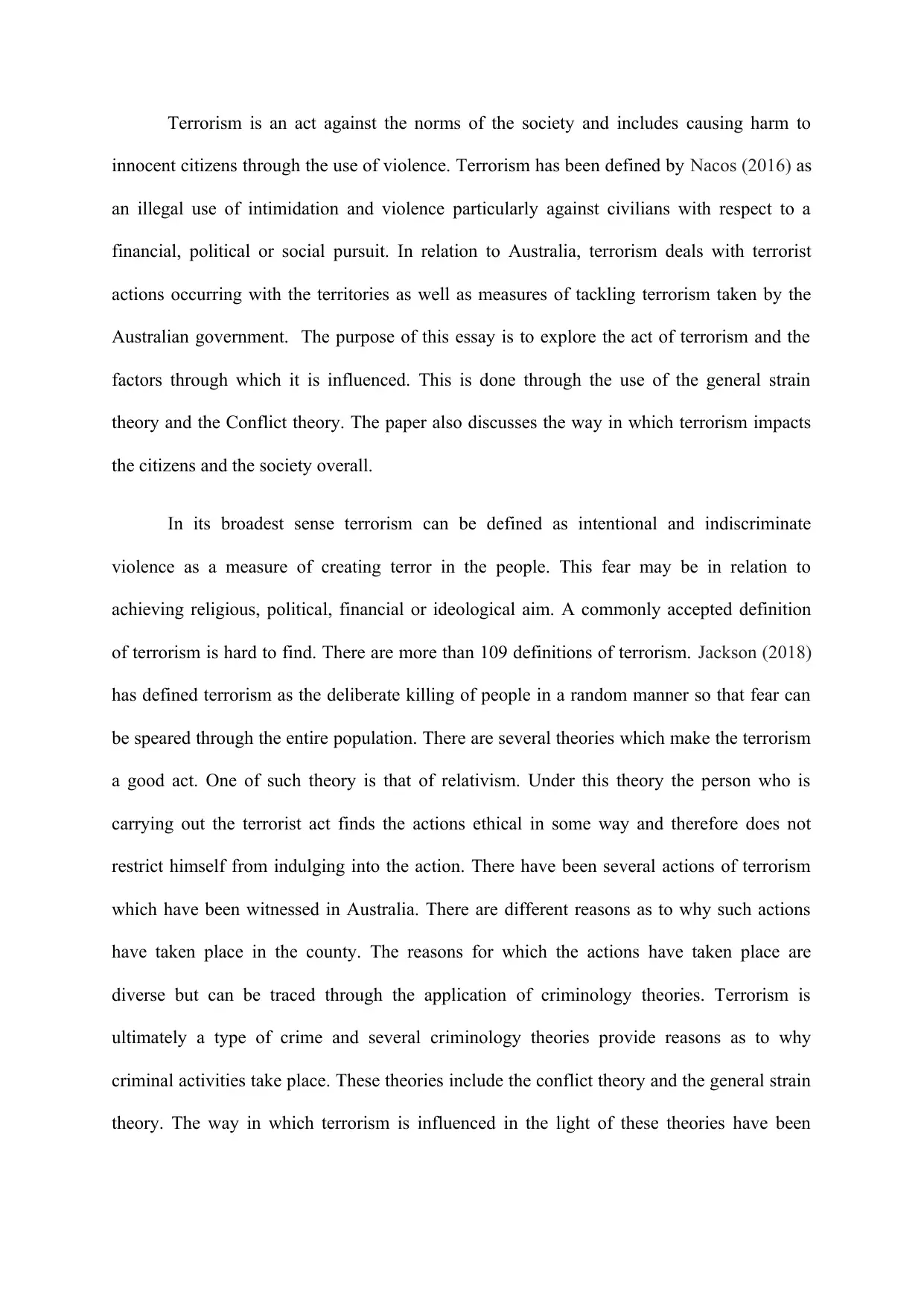
Terrorism is an act against the norms of the society and includes causing harm to
innocent citizens through the use of violence. Terrorism has been defined by Nacos (2016) as
an illegal use of intimidation and violence particularly against civilians with respect to a
financial, political or social pursuit. In relation to Australia, terrorism deals with terrorist
actions occurring with the territories as well as measures of tackling terrorism taken by the
Australian government. The purpose of this essay is to explore the act of terrorism and the
factors through which it is influenced. This is done through the use of the general strain
theory and the Conflict theory. The paper also discusses the way in which terrorism impacts
the citizens and the society overall.
In its broadest sense terrorism can be defined as intentional and indiscriminate
violence as a measure of creating terror in the people. This fear may be in relation to
achieving religious, political, financial or ideological aim. A commonly accepted definition
of terrorism is hard to find. There are more than 109 definitions of terrorism. Jackson (2018)
has defined terrorism as the deliberate killing of people in a random manner so that fear can
be speared through the entire population. There are several theories which make the terrorism
a good act. One of such theory is that of relativism. Under this theory the person who is
carrying out the terrorist act finds the actions ethical in some way and therefore does not
restrict himself from indulging into the action. There have been several actions of terrorism
which have been witnessed in Australia. There are different reasons as to why such actions
have taken place in the county. The reasons for which the actions have taken place are
diverse but can be traced through the application of criminology theories. Terrorism is
ultimately a type of crime and several criminology theories provide reasons as to why
criminal activities take place. These theories include the conflict theory and the general strain
theory. The way in which terrorism is influenced in the light of these theories have been
innocent citizens through the use of violence. Terrorism has been defined by Nacos (2016) as
an illegal use of intimidation and violence particularly against civilians with respect to a
financial, political or social pursuit. In relation to Australia, terrorism deals with terrorist
actions occurring with the territories as well as measures of tackling terrorism taken by the
Australian government. The purpose of this essay is to explore the act of terrorism and the
factors through which it is influenced. This is done through the use of the general strain
theory and the Conflict theory. The paper also discusses the way in which terrorism impacts
the citizens and the society overall.
In its broadest sense terrorism can be defined as intentional and indiscriminate
violence as a measure of creating terror in the people. This fear may be in relation to
achieving religious, political, financial or ideological aim. A commonly accepted definition
of terrorism is hard to find. There are more than 109 definitions of terrorism. Jackson (2018)
has defined terrorism as the deliberate killing of people in a random manner so that fear can
be speared through the entire population. There are several theories which make the terrorism
a good act. One of such theory is that of relativism. Under this theory the person who is
carrying out the terrorist act finds the actions ethical in some way and therefore does not
restrict himself from indulging into the action. There have been several actions of terrorism
which have been witnessed in Australia. There are different reasons as to why such actions
have taken place in the county. The reasons for which the actions have taken place are
diverse but can be traced through the application of criminology theories. Terrorism is
ultimately a type of crime and several criminology theories provide reasons as to why
criminal activities take place. These theories include the conflict theory and the general strain
theory. The way in which terrorism is influenced in the light of these theories have been
Paraphrase This Document
Need a fresh take? Get an instant paraphrase of this document with our AI Paraphraser
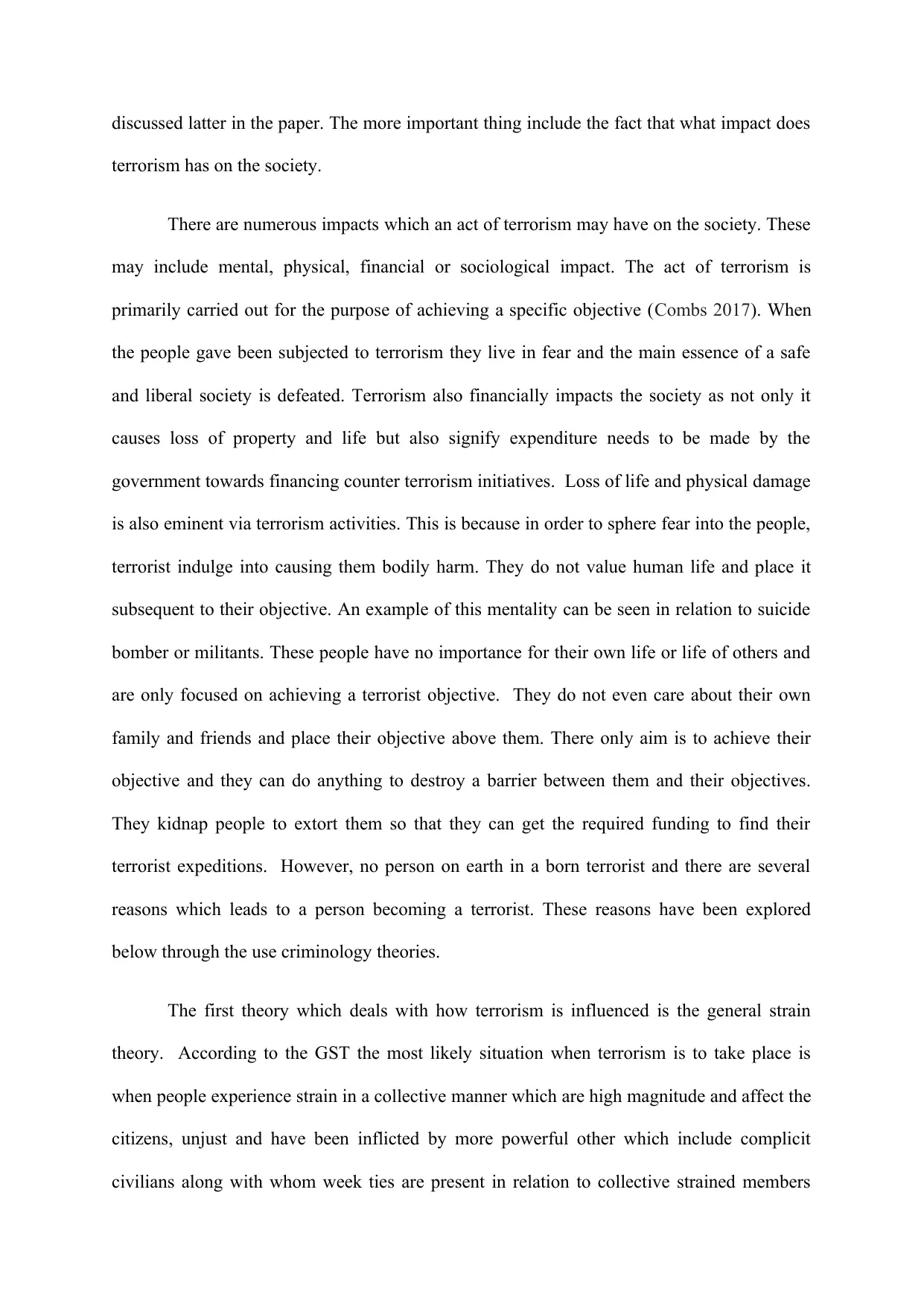
discussed latter in the paper. The more important thing include the fact that what impact does
terrorism has on the society.
There are numerous impacts which an act of terrorism may have on the society. These
may include mental, physical, financial or sociological impact. The act of terrorism is
primarily carried out for the purpose of achieving a specific objective (Combs 2017). When
the people gave been subjected to terrorism they live in fear and the main essence of a safe
and liberal society is defeated. Terrorism also financially impacts the society as not only it
causes loss of property and life but also signify expenditure needs to be made by the
government towards financing counter terrorism initiatives. Loss of life and physical damage
is also eminent via terrorism activities. This is because in order to sphere fear into the people,
terrorist indulge into causing them bodily harm. They do not value human life and place it
subsequent to their objective. An example of this mentality can be seen in relation to suicide
bomber or militants. These people have no importance for their own life or life of others and
are only focused on achieving a terrorist objective. They do not even care about their own
family and friends and place their objective above them. There only aim is to achieve their
objective and they can do anything to destroy a barrier between them and their objectives.
They kidnap people to extort them so that they can get the required funding to find their
terrorist expeditions. However, no person on earth in a born terrorist and there are several
reasons which leads to a person becoming a terrorist. These reasons have been explored
below through the use criminology theories.
The first theory which deals with how terrorism is influenced is the general strain
theory. According to the GST the most likely situation when terrorism is to take place is
when people experience strain in a collective manner which are high magnitude and affect the
citizens, unjust and have been inflicted by more powerful other which include complicit
civilians along with whom week ties are present in relation to collective strained members
terrorism has on the society.
There are numerous impacts which an act of terrorism may have on the society. These
may include mental, physical, financial or sociological impact. The act of terrorism is
primarily carried out for the purpose of achieving a specific objective (Combs 2017). When
the people gave been subjected to terrorism they live in fear and the main essence of a safe
and liberal society is defeated. Terrorism also financially impacts the society as not only it
causes loss of property and life but also signify expenditure needs to be made by the
government towards financing counter terrorism initiatives. Loss of life and physical damage
is also eminent via terrorism activities. This is because in order to sphere fear into the people,
terrorist indulge into causing them bodily harm. They do not value human life and place it
subsequent to their objective. An example of this mentality can be seen in relation to suicide
bomber or militants. These people have no importance for their own life or life of others and
are only focused on achieving a terrorist objective. They do not even care about their own
family and friends and place their objective above them. There only aim is to achieve their
objective and they can do anything to destroy a barrier between them and their objectives.
They kidnap people to extort them so that they can get the required funding to find their
terrorist expeditions. However, no person on earth in a born terrorist and there are several
reasons which leads to a person becoming a terrorist. These reasons have been explored
below through the use criminology theories.
The first theory which deals with how terrorism is influenced is the general strain
theory. According to the GST the most likely situation when terrorism is to take place is
when people experience strain in a collective manner which are high magnitude and affect the
citizens, unjust and have been inflicted by more powerful other which include complicit
civilians along with whom week ties are present in relation to collective strained members
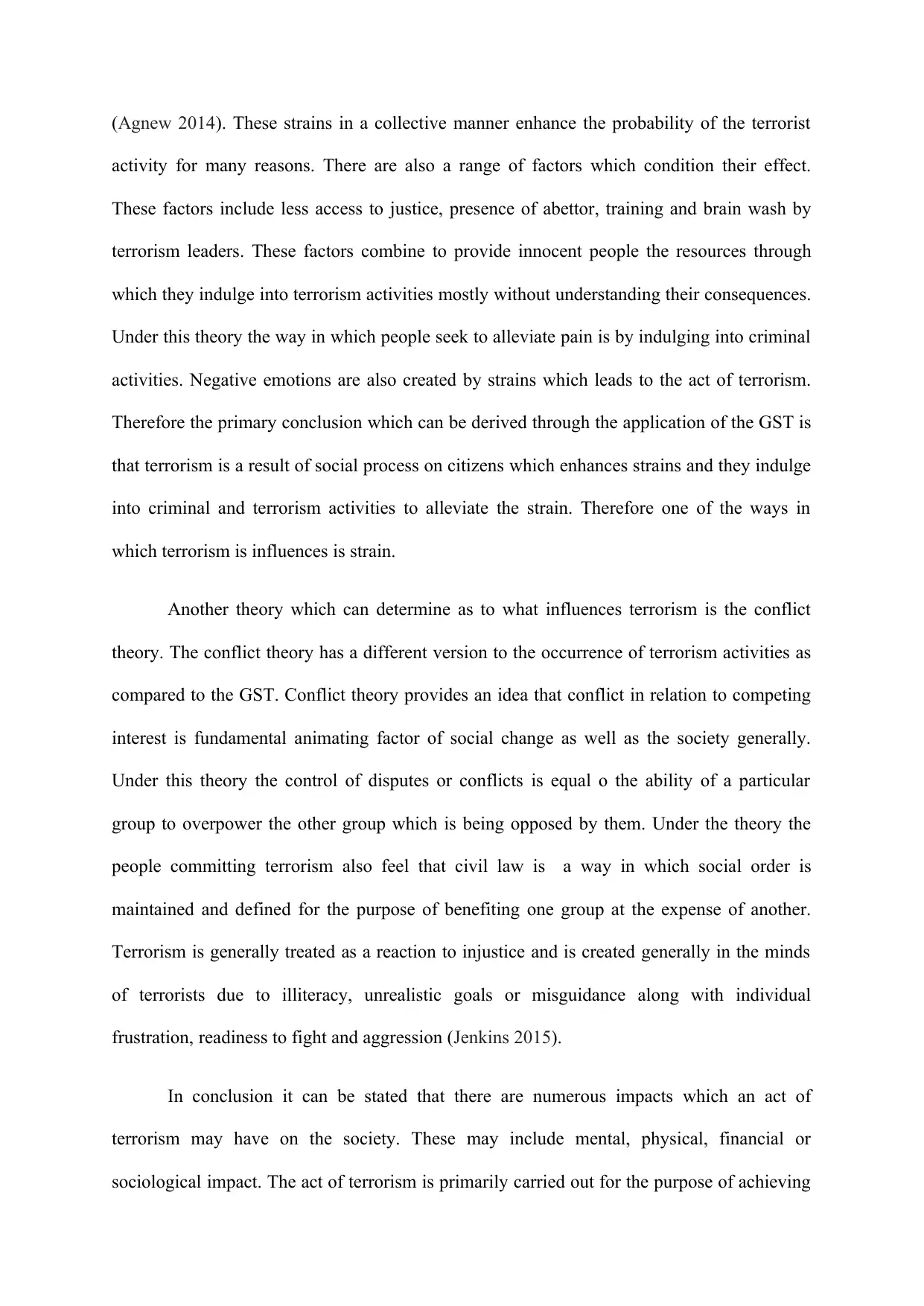
(Agnew 2014). These strains in a collective manner enhance the probability of the terrorist
activity for many reasons. There are also a range of factors which condition their effect.
These factors include less access to justice, presence of abettor, training and brain wash by
terrorism leaders. These factors combine to provide innocent people the resources through
which they indulge into terrorism activities mostly without understanding their consequences.
Under this theory the way in which people seek to alleviate pain is by indulging into criminal
activities. Negative emotions are also created by strains which leads to the act of terrorism.
Therefore the primary conclusion which can be derived through the application of the GST is
that terrorism is a result of social process on citizens which enhances strains and they indulge
into criminal and terrorism activities to alleviate the strain. Therefore one of the ways in
which terrorism is influences is strain.
Another theory which can determine as to what influences terrorism is the conflict
theory. The conflict theory has a different version to the occurrence of terrorism activities as
compared to the GST. Conflict theory provides an idea that conflict in relation to competing
interest is fundamental animating factor of social change as well as the society generally.
Under this theory the control of disputes or conflicts is equal o the ability of a particular
group to overpower the other group which is being opposed by them. Under the theory the
people committing terrorism also feel that civil law is a way in which social order is
maintained and defined for the purpose of benefiting one group at the expense of another.
Terrorism is generally treated as a reaction to injustice and is created generally in the minds
of terrorists due to illiteracy, unrealistic goals or misguidance along with individual
frustration, readiness to fight and aggression (Jenkins 2015).
In conclusion it can be stated that there are numerous impacts which an act of
terrorism may have on the society. These may include mental, physical, financial or
sociological impact. The act of terrorism is primarily carried out for the purpose of achieving
activity for many reasons. There are also a range of factors which condition their effect.
These factors include less access to justice, presence of abettor, training and brain wash by
terrorism leaders. These factors combine to provide innocent people the resources through
which they indulge into terrorism activities mostly without understanding their consequences.
Under this theory the way in which people seek to alleviate pain is by indulging into criminal
activities. Negative emotions are also created by strains which leads to the act of terrorism.
Therefore the primary conclusion which can be derived through the application of the GST is
that terrorism is a result of social process on citizens which enhances strains and they indulge
into criminal and terrorism activities to alleviate the strain. Therefore one of the ways in
which terrorism is influences is strain.
Another theory which can determine as to what influences terrorism is the conflict
theory. The conflict theory has a different version to the occurrence of terrorism activities as
compared to the GST. Conflict theory provides an idea that conflict in relation to competing
interest is fundamental animating factor of social change as well as the society generally.
Under this theory the control of disputes or conflicts is equal o the ability of a particular
group to overpower the other group which is being opposed by them. Under the theory the
people committing terrorism also feel that civil law is a way in which social order is
maintained and defined for the purpose of benefiting one group at the expense of another.
Terrorism is generally treated as a reaction to injustice and is created generally in the minds
of terrorists due to illiteracy, unrealistic goals or misguidance along with individual
frustration, readiness to fight and aggression (Jenkins 2015).
In conclusion it can be stated that there are numerous impacts which an act of
terrorism may have on the society. These may include mental, physical, financial or
sociological impact. The act of terrorism is primarily carried out for the purpose of achieving
⊘ This is a preview!⊘
Do you want full access?
Subscribe today to unlock all pages.

Trusted by 1+ million students worldwide
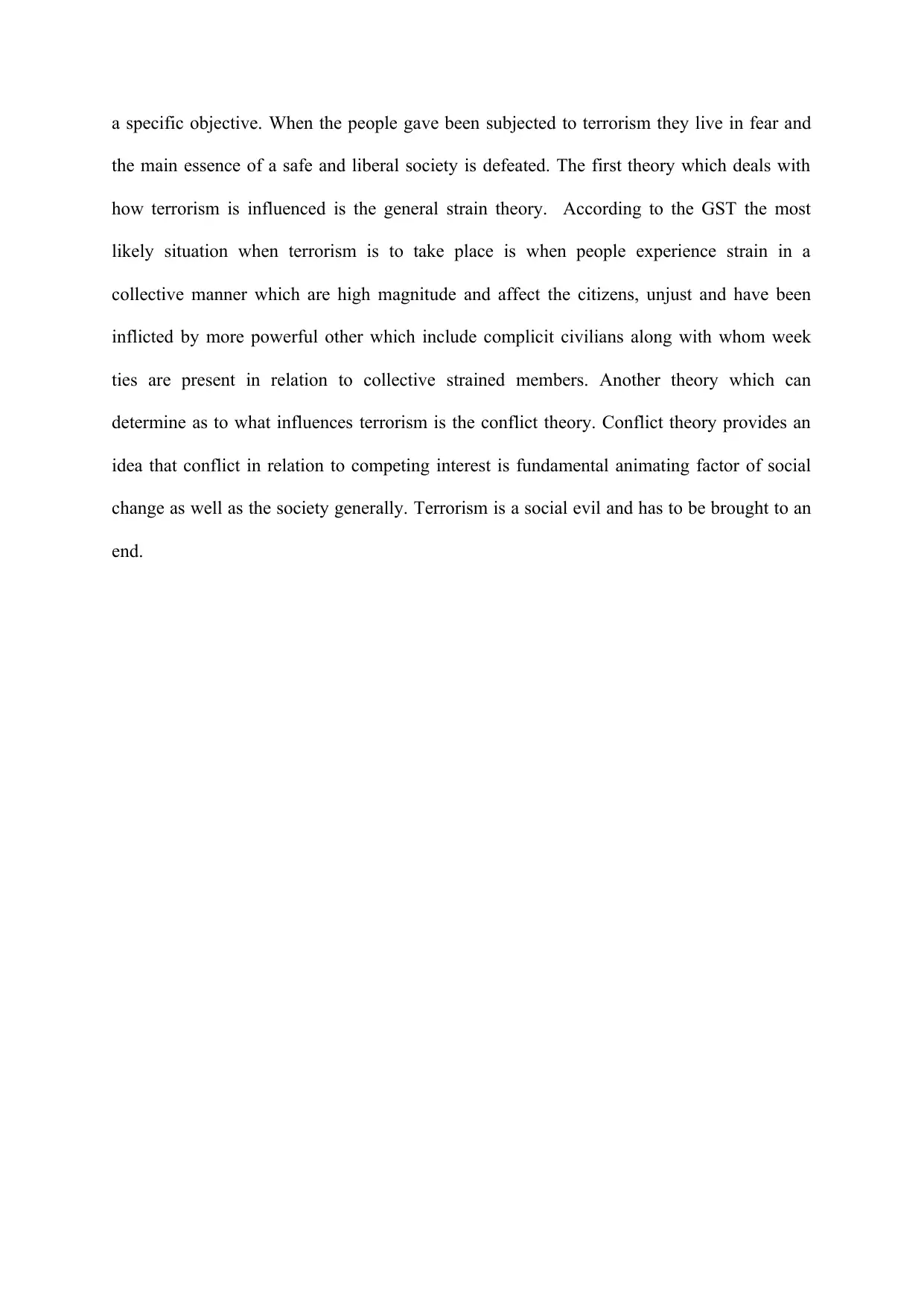
a specific objective. When the people gave been subjected to terrorism they live in fear and
the main essence of a safe and liberal society is defeated. The first theory which deals with
how terrorism is influenced is the general strain theory. According to the GST the most
likely situation when terrorism is to take place is when people experience strain in a
collective manner which are high magnitude and affect the citizens, unjust and have been
inflicted by more powerful other which include complicit civilians along with whom week
ties are present in relation to collective strained members. Another theory which can
determine as to what influences terrorism is the conflict theory. Conflict theory provides an
idea that conflict in relation to competing interest is fundamental animating factor of social
change as well as the society generally. Terrorism is a social evil and has to be brought to an
end.
the main essence of a safe and liberal society is defeated. The first theory which deals with
how terrorism is influenced is the general strain theory. According to the GST the most
likely situation when terrorism is to take place is when people experience strain in a
collective manner which are high magnitude and affect the citizens, unjust and have been
inflicted by more powerful other which include complicit civilians along with whom week
ties are present in relation to collective strained members. Another theory which can
determine as to what influences terrorism is the conflict theory. Conflict theory provides an
idea that conflict in relation to competing interest is fundamental animating factor of social
change as well as the society generally. Terrorism is a social evil and has to be brought to an
end.
Paraphrase This Document
Need a fresh take? Get an instant paraphrase of this document with our AI Paraphraser
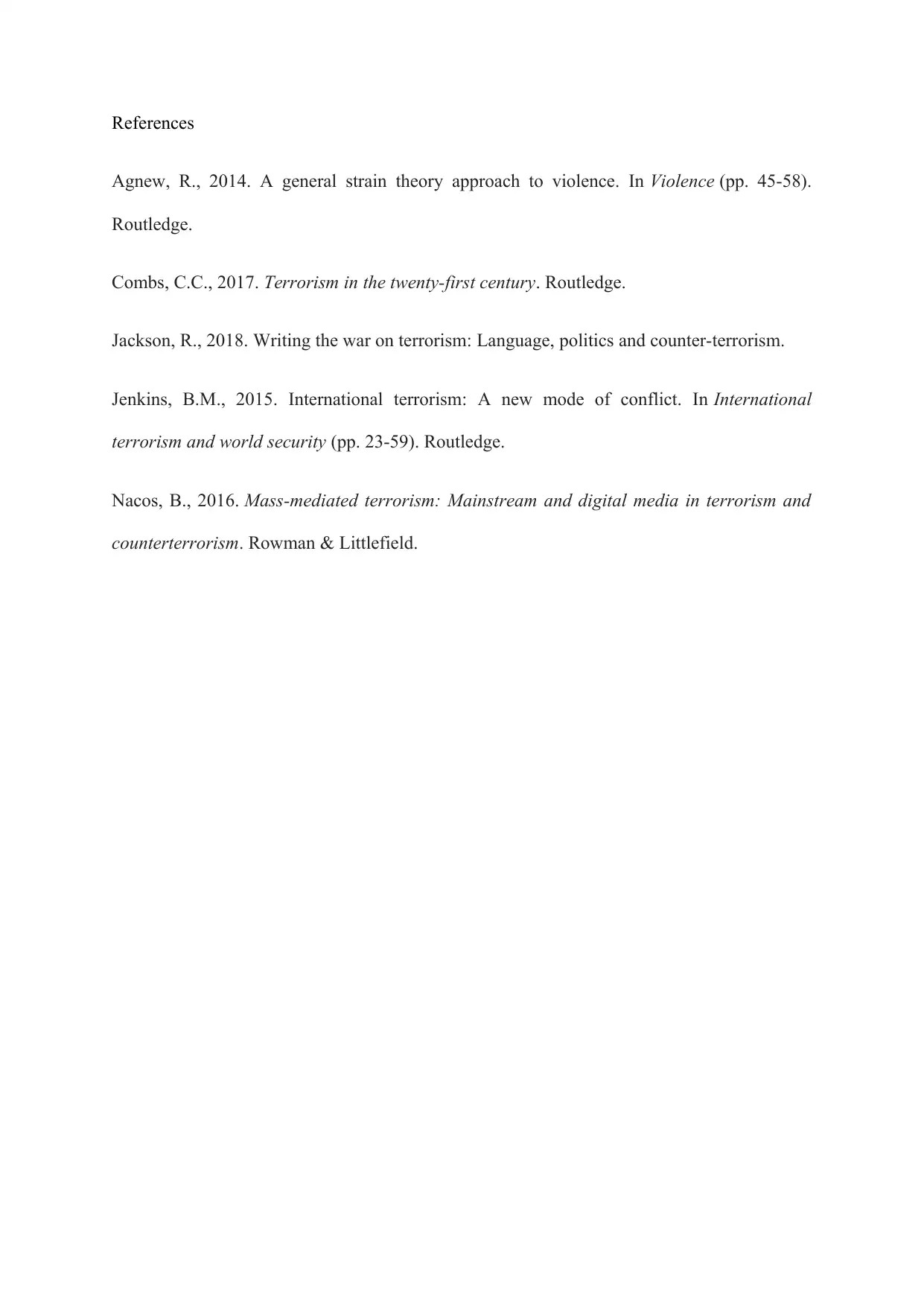
References
Agnew, R., 2014. A general strain theory approach to violence. In Violence (pp. 45-58).
Routledge.
Combs, C.C., 2017. Terrorism in the twenty-first century. Routledge.
Jackson, R., 2018. Writing the war on terrorism: Language, politics and counter-terrorism.
Jenkins, B.M., 2015. International terrorism: A new mode of conflict. In International
terrorism and world security (pp. 23-59). Routledge.
Nacos, B., 2016. Mass-mediated terrorism: Mainstream and digital media in terrorism and
counterterrorism. Rowman & Littlefield.
Agnew, R., 2014. A general strain theory approach to violence. In Violence (pp. 45-58).
Routledge.
Combs, C.C., 2017. Terrorism in the twenty-first century. Routledge.
Jackson, R., 2018. Writing the war on terrorism: Language, politics and counter-terrorism.
Jenkins, B.M., 2015. International terrorism: A new mode of conflict. In International
terrorism and world security (pp. 23-59). Routledge.
Nacos, B., 2016. Mass-mediated terrorism: Mainstream and digital media in terrorism and
counterterrorism. Rowman & Littlefield.
1 out of 5
Related Documents
Your All-in-One AI-Powered Toolkit for Academic Success.
+13062052269
info@desklib.com
Available 24*7 on WhatsApp / Email
![[object Object]](/_next/static/media/star-bottom.7253800d.svg)
Unlock your academic potential
Copyright © 2020–2025 A2Z Services. All Rights Reserved. Developed and managed by ZUCOL.




